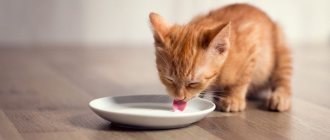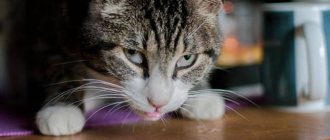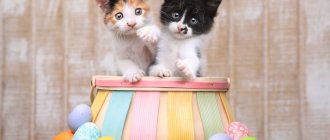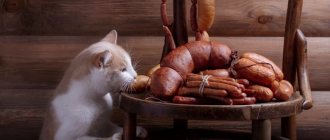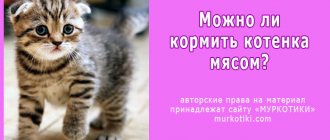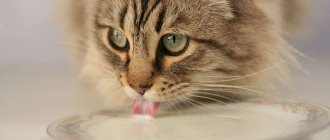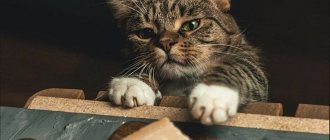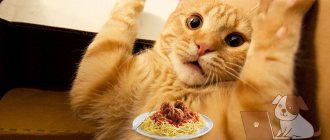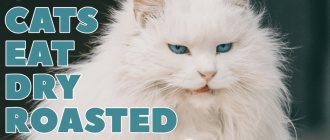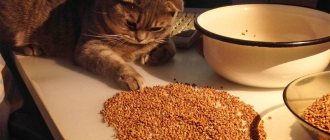The appearance of a Scottish kitten in a family is a joy for everyone, but also a great responsibility. It is necessary not only to equip a place for rest, to purchase everything necessary to keep a pet, but also to create a diet and decide what to feed the Scottish kitten. Regardless of the type of Scottish breed: Scottish Fold, Highland Fold - fold-eared kitten or Scottish Straight, Highland Straight - straight-eared kitten, from the first days babies need a balanced diet.
It is advisable to purchase Scots at 3 months of age, when kittens are weaned from breastfeeding. The owner is faced with the difficult task of how to create the correct nutritional system for the pet as it develops. The health and life expectancy of a Scottish cat depends on the quality, quantity and variety of food.
Can Scottish Folds be given milk?
The myth that fold-eared cats will develop funny curved ears from milk was invented by unscrupulous breeders. False information is shared for one's own benefit.
The fact is that purebred and expensive Scottish Folds have three folds on their ears, and as the kitten grows, they do not allow the ears to straighten. During breeding, for the sake of speedy profit and non-compliance with purebred mating, kittens appear with one fold, which smooths out with age and their ears stand up. Such babies should be sold much cheaper than their purebred brothers, which is why buyers listen to the fairy tale about milk and calcium, buying culls at an inappropriate price. The kitten will never refuse such a treat as milk, and when asked about erect ears, the seller will have a ready answer about non-compliance with the recommendations.
The benefits and harms of milk
Milk is a unique product created by nature. In addition to proteins and fats, it contains trace elements and minerals necessary for a growing body, calcium and potassium, phosphorus and magnesium, vitamins and lactose.
Lactose is milk sugar that is easily digestible and broken down by enzymes, but with age they disappear and the body stops absorbing milk.
In many individuals of the cat tribe, this restructuring occurs after the transition to solid food. With a lack of trace elements and calcium, curvature of the hind limbs, fragility of bones and claws may occur.
Special ready-made food: what to prefer
The most important rule in this case is that the food must be “premium class”. Even if such food is more expensive, it will definitely not cause harm and will be beneficial. As for the consistency, breeders especially like to feed their little charges mousse - it is most convenient to eat.
Food for babies must be designed for their age, since pellets for adult animals are larger and, as a result, inconvenient. As for brands, you should pay attention to the following:
- “Hills” - contains phosphorus, magnesium, calcium in excellent balance. It has a medicinal line of foods available, but you should first consult with a veterinarian about the advisability of using them.
- "Royal Canin" - contains enough fiber and an acceptable dosage of quickly digestible proteins. Helps create an optimal balance of intestinal flora and normalize the animal's stool.
- “Innova EVO” is favored by experienced breeders due to its composition of fresh meat and vegetables, oils, minerals, and vitamins. Fats and oils have a good effect on the immunity of kittens, and the absence of harmful impurities and even taste and smell enhancers guarantees high quality food.
- “Matisse” - most of the composition is chicken meat and fat, rice, fish, eggs. In addition, the food contains a whole complex of vitamins and calcium.
Scottish is a breed that attracts with its beauty and dignity. However, for all this, just a good pedigree is not enough - care is also of no small importance. But there is nothing complicated about the issue of proper feeding if you figure it out in advance and don’t improvise on the fly.
Previous
Scottish Straight (Scottish Straight)We buy Scottish Straight - selection and prices
Next
Scottish Straight (Scottish Straight) Scottish Straight health - diseases, prevention, vaccinations and basic information
How to feed fold-eared kittens correctly
There is no need to deprive a lop-eared Scot of such a delicacy. Natural cow's milk is diluted with boiled water 1:2; in this form it will not cause any harm and will be easily digested by the kitten. Milk is given separately and not mixed with other natural foods.
Cottage cheese, kefir, fermented baked milk or any other fermented milk product, fish, egg yolk will sufficiently replenish the growing body with calcium and potassium without consequences.
A properly selected diet and calcium content in food is important for the growth and formation of the musculoskeletal system. Such a large breed as the Scottish Fold requires high-quality and nutritious nutrition.
Source
Breed Features
The Scottish Fold, or Scottish Fold, is a naturally occurring breed. A cat with curled ears was born in Scotland and gave similar offspring. Then breeders began breeding the breed. Now folds can be found everywhere.
Adult Scottish Folds are medium sized, strong built, with thick, soft fur. It can be of different colors: plain, with a pattern or white splashes.
Scottish Folds are friendly, unpretentious in feeding and care, and very attractive in appearance. These qualities allowed the Scots to fall in love and spread along with British cats.
Features of the breed that determine the principles of feeding:
- Fold-eared Scots appeared naturally, in natural conditions. This influenced the preservation of predatory instincts among modern Scots. Therefore, the basis of the diet should be meat products.
- Formation of the jaw and replacement of teeth. This process occurs during the first 6 months of life. Oral hygiene comes to the fore. During this period, food should be soft so that the kitten can chew it comfortably. If feeding occurs incorrectly, the following symptoms will be detected: salivation, unpleasant odor, yellowing of the enamel, formation of tartar, swelling of the gums.
- Tendency to obesity. Scottish Folds can quickly gain weight if they are overfed. Therefore, it is important to follow the feeding regime and not exceed the daily calorie intake. At an early age, this is not a threat, since kittens are very active and playful, so calories will be spent on replenishing energy, growth and development.
- Susceptibility to diseases: constipation, bladder stones, heart pathologies. This leads to the fact that the diet must be balanced in nutrients and nutrients. It is important to pay attention to prohibited products.
- Late development. Scots, unlike wild breeds, develop more slowly, which affects the first feeding. The optimal period for introducing solid food is 1 month.
- The importance of diet choices. The psychological characteristics and health and appearance of an adult animal depend on the first feeding. Thus, with the introduction of meat products, kittens will learn hunting skills earlier and develop dexterity.
Nutrition is an important condition for the normal growth and development of Scottish Fold kittens. It must be balanced, designed for the needs of a growing organism. When feeding, it is important to take into account breed characteristics in order to avoid health problems for your pet.
Can Scottish Fold cats have milk?
There is an opinion that Scottish Fold cats should not drink milk and generally consume a lot of foods rich in calcium, so that their ears do not stand up. Is it so? And if so, then why can’t lop ears have milk?
In fact, there is no evidence that calcium products affect the process of ear erection in Folds, despite the fact that some breeders often scare buyers with this. According to veterinarians, in this way unscrupulous “breeders” absolve themselves of responsibility for erect ears in the future: they say, they were fed incorrectly - so they straightened up. True, some illiterate veterinarians themselves believe in this myth.
As practice shows, folds' ears can stand up for other reasons. And this has absolutely nothing to do with whether a Scottish kitten can have milk. One of the reasons is genetic: if a kitten’s genes are not ideal, and its ancestors have erect ears, then with a high degree of probability his ears will stand up too. Only many dishonest breeders are silent about this.
In fact, calcium is vital for fold-eared cats, as well as for straight-eared ones, because it is a building material for bones. Therefore, even if there was a choice whether to give the cat foods rich in calcium so that he would be healthy, or not so that he would be beautiful but sick, a conscientious cat owner would still choose the first option.
However, milk is still undesirable for Scottish kittens from a certain age. True, not at all because their ears can stand up. The fact is that, starting from 3 months, almost all cats cannot fully process lactose. As a result, they, like people, develop intolerance. In this case, the cat may greedily pounce on a bowl of milk, but its behavior in this case does not mean anything. Yes, cats love milk, but, as a rule, it doesn’t make them feel good afterwards. Drinking milk results in indigestion, diarrhea and gas. Sometimes the signs of dyspepsia are not clearly expressed - and the owners do not understand that the cat is unwell. However, most cats can drink milk in quantities of no more than 40 grams per 1 kilogram of animal weight without consequences.
At the same time, it is beneficial for both kittens and adult cats to eat fermented milk products: they are also rich in calcium, and they also normalize the intestinal microflora. The main thing is that they are not too greasy. This is kefir, fermented baked milk, yogurt, sugar-free yogurt, but not sour cream. Fermented milk products are served in a separate bowl; they do not need to be mixed with anything.
If you still have a strong desire to feed an adult cat milk, then it is better to opt for special lactose-free milk for cats. And if the cat really likes fatty sour cream, then it can be given occasionally after eating low-fat food in a small amount.
As for newborn kittens, who for some reason do not have a mother or she is not able to feed them herself, they definitely need milk. But there are some nuances here, which are described in a separate article.
For reference: the remainder of cow's milk per 100 g of product
Source
Milk for adult cats
Dairy products for cats, just like milk for cats, are a great treat. Milk can be given to cats if individual tolerance is good and there are no allergic manifestations. But it should be noted that castrated cats are prone to obesity, and cow product contains 149 kcal.
Therefore, drinking plenty of this drink together with dry food or food from the table can lead to an increase in the weight of the animal, which will negatively affect the cat’s body as a whole.
Therefore, you need to feed your cat dairy products in moderate doses. For a cat, as a more active creature than a lazy cat, these calories are not so significant, so cats can drink milk in any volume.
Is it possible to give milk to a Scottish Fold kitten?
In movies they often show how a bowl of cold milk is poured in front of a cat and she drinks it with pleasure. However, in the real world, giving your cat milk can do more harm than good. Although it may seem natural for a cat to drink milk, this is not entirely true. The truth is that cow's milk has no nutritional value for cats, and in fact, it can cause digestive problems for many. The reason is that most cats develop lactose intolerance shortly after weaning from their mother. This means they cannot digest the sugars found in natural milk, leading to digestive problems such as diarrhea.
How to tell if your pet is lactose intolerant
Most cat owners do not know that their pets are lactose intolerant, so they calmly give them dairy products. Upon reaching 3 months of age, the kitten stops producing lactase, an enzyme that breaks down lactose.
Interesting! In some cats that have been fed milk from a very young age and throughout their adulthood, the gastrointestinal tract continues to produce lactase. Such individuals consume dairy products without adverse health consequences.
After your cat drinks milk, he may experience symptoms that indicate lactose intolerance:
Usually all unpleasant symptoms disappear in cats within 8–12 hours, but sometimes they can persist for several days.
Before giving milk to a cat, the owner must make sure that the cat is not lactose intolerant. To do this, it is recommended to offer your pet a small amount of the product and observe it for several hours. If no signs of intolerance are found in your pet, you can treat him with milk. you need to gradually increase the dose and constantly monitor the reaction.
What to feed a Scottish kitten by month
Purebred kittens are very picky about their diet. This ordinary cat can be fed soup or bread, and it will be satisfied. In order to raise a Scottish cat that corresponds to the breed characteristics, you should take care of its nutrition from the moment of planned conception. It is very important that the cat from whom you plan to have offspring eats adequately before mating, during pregnancy and several months after the birth of the babies. The milk feeding period is important for the proper functioning of the gastrointestinal tract of babies. When trying to find out what to feed Scottish kittens, there are several important points to consider.
Nutrition of Scottish cats for various diseases
When a Scottish cat is sick, his diet, both natural and commercial, must be changed according to the nature of the illness.
Industrial feed
| Feed | Disease |
| Hill's Prescription Diet s/d | Stones in the kidneys. |
| Hill's Prescription Diet j/d | Joint diseases. |
| Hill's Prescription Diet z/d | Food allergies. |
| Hill's Prescription Diet Metabolic + Urinary | Obesity can be used to feed Scottish cats that have previously suffered from urolithiasis in order to prevent relapse. |
| ROYAL CANIN Skin Young Male | Skin diseases, hypersensitivity. |
Changes in natural feeding
Only a veterinarian can tell which foods should be excluded from the diet of a sick pet for various diseases, based on the characteristics of the clinical case. General recommendations for changing the diet of a sick cat are to avoid fish and foods high in salt.
Types of food
There are several options for feeding cats:
- natural, when the pet is offered a choice of meat, fish, minced animals;
- feeding with industrial feeds. These can be dry treats or jelly-like canned foods;
- mixed option, but it is not recommended to literally mix dry food and natural products. For breakfast there can be canned food, and for dinner a full-fledged minced chicken cutlet.
Veterinarians do not recommend using a mixed version, citing the fact that in this case it is difficult to avoid an overdose of vitamin supplements. An imbalance of vitamins and minerals in the body causes disturbances in the functioning of the body. Also, with mixed feeding, animals often experience digestive disorders and constipation, which can lead to diseases of the gastrointestinal tract.
The choice of food depends on the owner’s employment, their financial capabilities, and the pet’s taste preferences. It should be remembered that the diet should be varied, but at the same time balanced. Obesity is dangerous to the health of any cat. Problems with excess weight arise if the owners do not control the calorie content of their dishes and indulge their constantly meowing pet.
It is best to feed animals according to a schedule and a pre-compiled menu. Neutered cats are usually found with the problem of excess body weight, so special attention is paid to their diet.
Many pet owners argue about the correct choice of food. Some insist on a natural diet, others say that industrial feed is much healthier and tastier. It is difficult to prove anyone is right in this situation. Feeding natural foods is problematic for many. This requires frequent trips to the market or store. Meat and fish must be fresh.
In addition, fresh meat and fish delicacies may contain worm larvae, which can lead to the development of helminthiasis. To avoid infection, you will need to boil or bake a dish for cats, because fried food is harmful not only to the human body, but also to the cat’s stomach.
Ready-made food does not take much time to feed. It is enough to pour a certain portion to clearly know that your pet will not go hungry until the evening.
Adult pet diet
The structure of the digestive system of all cats is not particularly different, therefore, for an adult cat from the Scottish Fold and Straight-eared species, the food does not differ in composition. The main thing is to provide your pet with a varied, high-quality and balanced diet.
Table No3. Diet of an adult Scottish Fold or Straight-eared cat.
Dry and wet food
Ready-made food from manufacturers of dry and wet products has the following advantages:
- Convenient for feeding, it is produced in production in the form of mixtures: - pastes, pieces of jelly, canned food and dry pads. Doesn't take much time to cook.
- The composition fully takes into account the cat’s need for a complex of beneficial substances for the body with the addition of vitamins, minerals, and herbal ingredients.
- For each type of product, a dosage of the daily amount required for a balanced diet has been developed.
- The mixtures include natural products processed using a special technology that ensures long-term storage.
Food is produced in different categories: holistic, super-premium, premium, economy class, consistent with the age of the kitten.
The finished food is easily digested by the animal’s body and is eaten with pleasure.
When switching Scottish cats to ready-made food, you must adhere to the following feeding rules:
- Choose only high-quality food for feeding Scottish fold and straight-eared purebred cats: holistic, superpremium, premium class.
- Strictly follow the manufacturer's recommended daily or single dosage of the product indicated on the packaging.
- You can feed your pet in two modes:
- One-time, once a day, the entire amount of food is laid out in a bowl. So, it’s convenient to feed your pet for busy owners.
- Portioned, the entire daily dose is divided into shares and given to cats according to a time schedule. More useful for the cat, there is no threat of obesity.
- The animal is constantly provided with free access to water. Use bottled liquid and replace it with fresh one daily.
Important! It is advisable to decide what kind of food is best to feed your pet and choose products from one manufacturer that are age-appropriate. This will ensure control over the supply of nutrients in food.
Recommended food from finished product manufacturers for Scots: Royal Canin, Hill's Science Plan, FLATAZOR CROCKTAIL, Sanabelle.
Table No. 4. Popular companies producing cat food.
Natural nutrition
There is no doubt about whether it is worth feeding a Scottish kitten regular food and what food is best for kittens. Tasty, fresh food, natural in composition, close to the natural nutrition of animals. Properly selected food prepared from a variety of products will please your baby. When eating natural foods, vitamin complexes are additionally included in food.
Important! Breeders and veterinarians believe that natural products are much healthier than ready-made branded products in the form of canned food, pouches and dry food.
For the owner, daily cooking creates certain difficulties and requires a lot of time. Many people cut up a large complex amount of food in advance, including meat products, vegetables, eggs, herbs, for a week. The entire prepared mass is laid out in portions into bags and frozen. Use daily, giving to the pet after heating.
There are two power modes:
- Constant, when the daily amount of food is immediately placed in a large bowl. And the pet eats everything as desired. This regime is convenient for busy owners, but there is a risk of cat obesity.
- Portioned, when food is given out in small quantities several times a day, the cat gets used to not overeating, which is good for his health. This makes feeding convenient for those who are constantly at home and can maintain an hourly schedule.
Important! The natural nutrition basket of the Scottish fold and straight-eared cats consists of meat, vegetables, fermented milk, eggs, herbs and other products. Occasionally, you can pamper your pet with fish, seafood, and fruits.
is it possible to give milk
It is not recommended to give milk to adult cats due to the high lactose content. It can be replaced with fermented milk products as a source of calcium. Particularly important is low-fat cottage cheese, which is given 2 times a week, on other days kefir and fermented baked milk.
Meat
Meat is an obligatory daily product in the diet; its daily content makes up up to 70% of the total food. Scottish cats, known as mousecatchers, benefit from raw meat. It is well frozen in advance to get rid of parasites. Meat products include: beef, chicken, all other types of poultry except fatty breeds. All types of offal: stomachs, liver, heart, kidneys. The meat is cut into large pieces so that the pets develop jaws and sharpen their teeth.
Fish
Fish and seafood are very beneficial for cats, necessary for the growth and strengthening of bones. Low-fat varieties of any sea fish: hake, pollock, perch and other types are freed from bones and scalded. Included on the menu infrequently: 1-2 times a week. It is not recommended to give river fish, it is very bony and can damage the stomach.
Porridge
Buckwheat, barley, wheat, pearl barley, oatmeal porridge. They are cooked until fully cooked in water or milk, add a few drops of vegetable oil: Olive, flaxseed, sunflower. Porridges are mixed daily with meat, fish, and vegetables in a ratio of 1:3 of the total volume. Do not add salt or sugar. Recommended as complementary food for kittens from 5 months.
General feeding rules
Typically, kittens are purchased at the age of 3-4 months, when their body is able to do without mother’s milk and is partially accustomed to new “adult” food. To correctly create a menu and feed your baby, you need to take into account a number of factors:
- The baby's stomach is very small, and activity is increased, so feeding should be frequent and portions small. For example, at the age of 3 months, a kitten is fed 5-6 times a day, and an older 4-month-old baby needs to be fed 4 times a day;
- a pet that does not have enough food will develop poorly, lag behind its peers, and often get sick;
- overfeeding is also dangerous. Unspent calories will definitely lead to obesity and disease;
- new products are introduced gradually, starting with small portions. Feeding with different foods must be alternated, that is, meat for breakfast, fish for lunch, cottage cheese for dinner. This is how the stomach learns new tastes and gradually gets used to them;
- You can’t pour the entire daily portion into your baby’s plate. His stomach is not yet able to control itself, which is dangerous due to overeating;
- food should not be too hot or cold. The kitten may get burned or have a cold in its throat. It is advisable to slightly warm foods before feeding.
Choosing a place and dishes
Before purchasing a kitten, the owner needs to arrange a place where the pet will feed. Although the Scots are unpretentious, this is worth paying attention to. Therefore, choosing a place and utensils is no less important than feeding itself.
Containers for water and food must be stable and spacious. The minimum number of bowls is two pieces. However, with mixed feeding, you will need to purchase one container for each type of food and water.
Common bowl materials:
- Ceramics and faience. This option is considered optimal for Scottish kittens. The dishes are heavy, so they will not slide on the floor. Other advantages include: the ability to wash well and the lack of tendency to retain odors that can affect water and feed.
- Metal. Bowls made of this material are usually made on a stand or with an elastic band along the bottom rim, which prevents movement and sliding on the floor.
- Plastic. Main advantages: lightness of the dishes, stability, variety of shapes and sizes. However, there are also significant disadvantages - food residues getting into the cracks and retaining odors. Because of this, it is recommended to change plastic bowls frequently. External characteristics for suitable dishes are a wide diameter, low sides so that the bowl is not very deep. A container with a volume of up to 0.5 liters is suitable for food; you can take more for water.
The arrangement of the place is carried out taking into account behavioral characteristics.
Primary requirements:
- placing bowls next to each other;
- a permanent place for feeding, which will help the pet get used to it faster;
- placing a rug or tray under the dishes so that the bowls slip less and the floor does not get dirty.
The optimal place is a separate corner in the kitchen, away from noisy furnishings and bright light. The dishes must be washed at least once every 2 days, preferably without the use of detergents.
Remember! You should not wash cat bowls in the same place as human dishes, as animals often carry parasites.
Feeding frequency
The number of feedings depends on the age of the kitten. The approximate diet and number of feedings per day are presented in the table (on a mobile device you can scroll the table horizontally with your finger):
| Pet's age, months. | Number of feedings | Example of products and dishes used |
| 1 | 6-8 | Warm milk semolina porridge, baby formula, a small amount of boiled chicken yolk. |
| 2 | 5-6 | Low-fat cottage cheese, milk, semolina porridge, a small portion of boiled and chopped meat (10-15g). |
| 3 | 4-5 | Boiled minced meat, cottage cheese, kefir, chopped vegetables, baked or boiled fish, porridge. |
| 4-6 | 3-4 | Fermented milk products, meat, minced meat, cartilage, fish, fresh and boiled vegetables. |
| over 6 | 3-2 | All permitted products. |
Artificial feeding of a newborn kitten
Usually babies up to 1-3 months are fed by a mother cat. There are situations when the offspring is left without a mother, and a person takes on the role of nurse. This is a very important mission, which sometimes seems impossible. Nothing is impossible, the main thing is desire and skill. The best option is to ask your friends if they have a nursing cat. Usually the mother does not refuse to feed her foundlings.
If this option is not available, start feeding from a pipette. Before feeding, babies are weighed, this allows you to determine the required amount of food. A 100-gram baby will need 30 ml of formula or milk, which is how kittens are fed during the first week after birth.
Starting from the second week, the nutritional intake is increased. For every 100 g of baby's weight, at least 38 g of liquid food is needed. In the third week, at least 48 g is already required. Starting from the next month, the norm increases to 53 g.
During the first month, the baby should receive food multiple times (up to 10 times a day). For feeding, warm milk or cream is used, which is poured into the baby’s mouth using a pipette or syringe without a needle. This must be done carefully so that the kitten does not choke.
Cow's milk is slightly different in composition from cat's milk. For example, there is less water in cat milk (70%) than in cow milk (88%), and the fat content is higher - 11% and 3.25%, respectively. But the most important difference is the amount of lactose. There is almost 2 times more of it in cow milk (5.2%) than in cat milk (3%).
The pet store sells a special formula for newborn kittens, which is similar in composition to a cat's mother's milk and is more suitable for feeding babies than cow's milk.
Sample menu by age
Kittens grow, get stronger, and along with this their diet and feeding schedules change. To get out of the situation, it is important for the owner to know the approximate menu by age. For ready-made food, portion sizes and number of feedings are indicated on the packaging. With a natural diet it is more difficult.
Up to a month
From birth to one month, Scottish kittens feed on their mother's milk. If the babies are left without a mother, then the owner feeds them using industrial cat milk substitutes, baby formula, or self-prepared formula.
Important! If the kittens are left without maternal feeding, then it is better to find a nurse cat for them. If this is not possible, then you will have to make every effort to fatten with substitutes.
1 month
Upon reaching 1 month, Scottish Fold kittens begin to be introduced to the first complementary foods. Here you can go in two ways: start with raw scraped meat (chicken, beef) or low-fat fermented milk products (ryazhenka, cottage cheese, yogurt).
Feeding with mother's milk or substitute continues. The total amount of food per day is 110–130 grams, meals – 7–8, can be changed depending on the needs of small pets.
2 months
At 2 months, the transition period begins - the kittens are gradually weaned from their mother or the amount of substitute consumed is reduced. Solid foods become more varied. Grated vegetables and bran are added to meat and dairy products.
After two months, the amount of food per day reaches 170–190 grams, 6–7 meals.
3 months
Kittens begin to be distributed at 3 months of age. This is a difficult period for pets, so you should approach feeding responsibly. New foods are added to the diet.
The basis of nutrition is not scraped, but finely chopped meat. Fermented milk products, vegetables, and fruits are introduced more actively in small quantities. At 3 months old, Scots can be introduced to cereals.
Amount of food – 230–250 grams per day, meals – 4–5.
4–6 months
At the age of 4–6 months, fish is gradually introduced into the diet - no more than 2 times a week. The meat is given in larger pieces. Greens are added to vegetables and fruits, preferably special grass, which can be purchased at a pet store.
The daily food intake depends on the size of the kitten. If it is large, then they give 310–330 grams, with medium sizes – 280–300 grams.
The number of techniques is reduced to three.
From 6 months to 1 year
The period from 6 months to 1 year is considered the completion of the development of a kitten into an adult animal.
The diet is as varied as possible, all permitted products are added.
The number of doses is reduced to two, the daily rate is also reduced and amounts to 5% of the animal’s weight.
